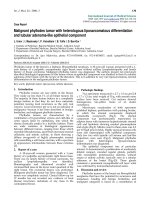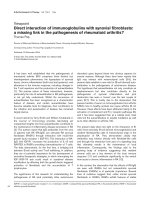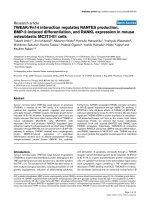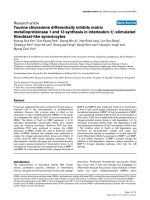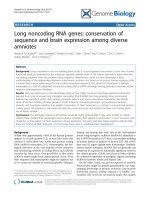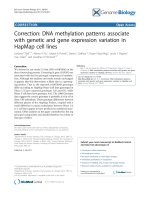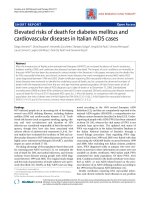Báo cáo y học: "TWEAK/Fn14 interaction regulates RANTES production, BMP-2-induced differentiation, and RANKL expression in mouse osteoblastic MC3T3-E1 cells" pot
Bạn đang xem bản rút gọn của tài liệu. Xem và tải ngay bản đầy đủ của tài liệu tại đây (3.78 MB, 10 trang )
Open Access
Available online />Page 1 of 10
(page number not for citation purposes)
Vol 8 No 5
Research article
TWEAK/Fn14 interaction regulates RANTES production,
BMP-2-induced differentiation, and RANKL expression in mouse
osteoblastic MC3T3-E1 cells
Takashi Ando
1
*, Jiro Ichikawa
2
*, Masanori Wako
2
, Kyosuke Hatsushika
1
, Yoshiyuki Watanabe
2
,
Michitomo Sakuma
2
, Kachio Tasaka
1
, Hideoki Ogawa
3
, Yoshiki Hamada
2
, Hideo Yagita
4
and
Atsuhito Nakao
1,3
1
Department of Immunology, Faculty of Medicine, University of Yamanashi, 1110 Shimokato, Chuo, Yamanashi 409-3898, Japan
2
Department of Orthopedic Surgery, Faculty of Medicine, University of Yamanashi, 1110 Shimokato, Chuo, Yamanashi 409-3898, Japan
3
Atopy Research Center, Juntendo University School of Medicine, 2-1-1, Hongo, Bunkyo-ku, Tokyo 113-8421, Japan
4
Department of Immunology, Juntendo University School of Medicine, 2-1-1, Hongo, Bunkyo-ku, Tokyo 113-8421, Japan
* Contributed equally
Corresponding author: Atsuhito Nakao,
Received: 17 Apr 2006 Revisions requested: 19 May 2006 Revisions received: 13 Jul 2006 Accepted: 1 Sep 2006 Published: 1 Sep 2006
Arthritis Research & Therapy 2006, 8:R146 (doi:10.1186/ar2038)
This article is online at: />© 2006 Ando et al.; licensee BioMed Central Ltd.
This is an open access article distributed under the terms of the Creative Commons Attribution License ( />),
which permits unrestricted use, distribution, and reproduction in any medium, provided the original work is properly cited.
Abstract
Tumour necrosis factor (TNF)-like weak inducer of apoptosis
(TWEAK), a member of the TNF family, is a multifunctional
cytokine that regulates cell growth, migration, and survival
principally through a TWEAK receptor, fibroblast growth factor-
inducible 14 (Fn14). However, its physiological roles in bone are
largely unknown. We herein report various effects of TWEAK on
mouse osteoblastic MC3T3-E1 cells. MC3T3-E1 cells
expressed Fn14 and produced RANTES (regulated upon
activation, healthy T cell expressed and secreted) upon TWEAK
stimulation through PI3K-Akt, but not nuclear factor-κB (NF-κB),
pathway. In addition, TWEAK inhibited bone morphogenetic
protein (BMP)-2-induced expression of osteoblast
differentiation markers such as alkaline phosphatase through
mitogen-activated protein kinase (MAPK) Erk pathway.
Furthermore, TWEAK upregulated RANKL (receptor activation
of NF-κB ligand) expression through MAPK Erk pathway in
MC3T3-E1 cells. All these effects of TWEAK on MC3T3-E1
cells were abolished by mouse Fn14-Fc chimera. We also found
significant TWEAK mRNA or protein expression in osteoblast –
and osteoclast-lineage cell lines or the mouse bone tissue,
respectively. Finally, we showed that human osteoblasts
expressed Fn14 and induced RANTES and RANKL upon
TWEAK stimulation. Collectively, TWEAK/Fn14 interaction
regulates RANTES production, BMP-2-induced differentiation,
and RANKL expression in MC3T3-E1 cells. TWEAK may thus
be a novel cytokine that regulates several aspects of osteoblast
function.
Introduction
Tumour necrosis factor (TNF)-like weak inducer of apoptosis
(TWEAK) is a type II transmembrane protein belonging to the
TNF superfamily and can also function as a secreted cytokine
like TNF-α [1]. The soluble form of TWEAK has been shown to
exert multiple biological activities, including stimulation of cell
growth, angiogenesis, induction of inflammatory cytokines,
and stimulation of apoptosis, principally through a TWEAK
receptor named fibroblast growth factor-inducible 14 (Fn14)
[2,3]. Fn14 is a type I transmembrane protein composed of
only one cysteine-rich domain in the extra-cellular region and a
short cytoplasmic region containing a TNF receptor-associ-
ated factor (TRAF)-binding motif [4,5]. TWEAK/Fn14 interac-
tion stimulates canonical and non-canonical nuclear factor-κB
ALP = alkaline phosphatase; BMP = bone morphogenetic protein; ELISA = enzyme-linked immunosorbent assay; Fn14 = fibroblast growth factor-
inducible 14; GAPDH = glyceraldehyde-3-phosphate dehydrogenase; GSK-3β = glycogen synthase kinase-3β; IgG = immunoglobulin G; mAb =
monoclonal antibody; NF-κB = nuclear factor-κB; PBS = phosphate-buffered saline; PCR = polymerase chain reaction; RANKL = receptor activation
of nuclear factor-κB ligand; RANTES = regulated upon activation, healthy T cell expressed and secreted; TGF = transforming growth factor; TNF =
tumour necrosis factor; TRAF = tumour necrosis factor receptor-associated factor; TWEAK = tumour necrosis factor-like weak inducer of apoptosis.
Arthritis Research & Therapy Vol 8 No 5 Ando et al.
Page 2 of 10
(page number not for citation purposes)
(NF-κB) signaling pathways mediated by IκBα phosphoryla-
tion and p100 processing via TRAF molecules [6] and also
stimulates mitogen-activated protein kinases (MAPKs) JNK (c-
Jun NH
2
-terminal kinase), p38, and Erk [7].
We and others have shown that TWEAK/Fn14 interaction
plays important roles in proliferation, migration, inflammatory
responses, and survival in a variety of cell types, including
endothelial, epithelial, immune, and some tumour cells [2,3,8-
11]. In bone, Polek et al. reported that TWEAK induced differ-
entiation of RAW264 monocyte/macrophage cells into osteo-
clasts in an Fn14-independent manner [12]. However, the
effects of TWEAK on osteoblastic cells and its interplay with
other cytokines still remain largely unknown.
In the present study, we thus investigated the biological
effects of TWEAK on mouse MC3T3-E1 cells, a clonal osteo-
genic cell line that maintains characteristics of primary osteob-
last progenitors and is frequently used for studying osteoblast
differentiation and function in vitro [13]. Our results suggest
that TWEAK/Fn14 interaction may regulate osteoblast
functions.
Materials and methods
Reagents
Recombinant mouse TWEAK, human bone morphogenetic
protein (BMP)-2, mouse TNF-α, and mouse Fn14-Fc chimera
were purchased from R&D Systems Inc. (Minneapolis, MN,
USA). Anti-Fn14 monoclonal antibody (mAb) (ITEM-1) was
generated in our laboratory as previously described [9].
PD98059 and LY294002 were purchased from Calbiochem
(San Diego, CA, USA), and Helenalin was purchased from
BIOMOL International, L.P. (Plymouth Meeting, PA, USA).
Cell culture
MC3T3-E1, RAW264, ATDC5, and EL4 cells were purchased
from Riken Cell Bank (Tsukuba, Japan). MC3T3-E1 cells were
maintained in α-minimal essential medium (Invitrogen,
Carlsbad, CA, USA) with L-glutamine supplemented with 10%
fetal calf serum, 100 μg/ml streptomycin, and 100 units per ml
penicillin G solution. Primary osteoblasts derived from healthy
human femoral bone from a patient with rheumatoid arthritis
were purchased from Cell Applications, Inc. (San Diego, CA,
USA) and were maintained using the manufacturer's recom-
mended growth medium and supplements.
Flow cytometric analysis
Cells (1 × 10
6
) were incubated with anti-Fn14 mAb (ITEM-1)
for 1 hour at 4°C, followed by phycoerythrin-labeled rabbit
anti-mouse immunoglobulin G (IgG) antibody (BD Pharmin-
gen, San Diego, CA, USA). After a washing with phosphate-
buffered saline (PBS), the cells were analyzed on a FACSCal-
ibur (BD Biosciences, San Jose, CA, USA), and the data were
analyzed with the WinMDI program (The Scripps Research
Institute, La Jolla, CA, USA).
Immunoblotting
Immunoblotting was performed as previously described [14]
with specific antibodies for phosphorylated (Ser536)-NF-κB
p65 (Cell Signaling Technology, Inc., Danvers, MA, USA),
phosphorylated-Akt and Akt (Becton, Dickinson and Com-
pany, Franklin Lakes, NJ, USA), and phosphorylated-Erk p42/
44 and Erk p42/44 (Cell Signaling Technology, Inc.).
Cytokine protein array
Cells (1 × 10
6
) were stimulated with 100 ng/ml TWEAK for 48
hours. The amounts of several cytokines in the culture super-
natants were then determined by using a cytokine protein array
(TranSignal Mouse Cytokine Antibody Array 1.0; Panomics,
Inc., Fremont, CA, USA) according to the manufacturer's
instructions.
Enzyme-linked immunosorbent assay
Cells (1 × 10
6
) were stimulated with 100 ng/ml TWEAK in the
presence or absence of the indicated inhibitors for 48 hours.
The amounts of RANTES (regulated upon activation, healthy T
cell expressed and secreted) in the culture supernatants were
then determined by using the mouse RANTES enzyme-linked
immunosorbent assay (ELISA) kit (R&D Systems Inc.) accord-
ing to the manufacturer's instructions.
Cell viability assay
Cells (5 × 10
3
) were cultured with or without 100 ng/ml
TWEAK in the presence or absence of the indicated inhibitors
in a flat-bottom 96-well microtiter plate. The number of viable
cells in each well was then determined by the WST (water-sol-
uble tetrazolium) assay with the Tetra Color ONE kit (Seika-
gaku Corporation, Tokyo, Japan) according to the
manufacturer's instructions.
Alkaline phosphatase assay
Cells (5 × 10
3
/well) were cultured with 100 ng/ml BMP-2 for
5 days in the presence or absence of the indicated inhibitors
in a flat-bottom 96-well plate. Alkaline phosphatase (ALP)
activity was determined by the TRACP & ALP double-stain kit
(Takara Bio Inc., Shiga, Japan).
Reverse transcription-polymerase chain reaction
Reverse transcription-polymerase chain reaction (PCR) was
performed as previously described [14]. PCR amplification
(osteocalcin: 94°C for 0.5 minutes, 58°C for 0.5 minutes, and
72°C for 1 minute [35 cycles]; β-actin: 94°C for 0.5 minutes,
56°C for 0.5 minutes, and 72°C for 1 minute [35 cycles]) was
performed in a DNA engine cycler (MJ Research, Inc., Water-
town, MA, USA). The PCR products were separated by 2.0%
agarose gel electrophoresis and stained with 0.5 μg/ml ethid-
ium bromide. The primers used were mouse osteocalcin (for-
ward, 5'-GCAGCTTGGTGCACACCTAG-3'; reverse, 5'-
GGAGCTGCTGTGACATCCAT-3') and mouse β-actin (for-
ward, 5'-TGGAATCCTGTGGCATCCATGAAAC-3'; reverse,
5'-TAAAACGCAGCTCAGTAACAGTCCG-3').
Available online />Page 3 of 10
(page number not for citation purposes)
Quantitative real-time PCR
Total RNA was extracted from cells (1 × 10
6
) or Balb/c mouse
tissues. cDNA was then synthesised from 2 μg of total RNA
by using the Reverse Transcriptase System (Applied Biosys-
tems, Foster City, CA, USA). Quantitative PCR analysis was
performed using the ABI7500 real-time PCR system (Applied
Biosystems) according to the manufacturer's instructions.
Primers and probes for mouse RANKL (receptor activation of
nuclear factor-κB ligand), mouse TWEAK, and glyceralde-
hyde-3-phosphate dehydrogenase (GAPDH) were purchased
from Applied Biosystems. The ratio of each gene to that of
GAPDH was calculated, and the value of 1.0 was assigned to
cells that were incubated without transforming growth factor
(TGF)-β1 or TWEAK.
Immunofluorescence study
Cells were grown on eight-well culture slides with 100 ng/ml
TWEAK for 24 or 48 hours, washed with PBS, and fixed with
4% paraformaldehyde. After permeabilisation, slides were
stained with goat polyclonal anti-RANKL antibody or control
goat IgG (Santa Cruz Biotechnology, Inc., Santa Cruz, CA,
USA) diluted in PBS overnight at 4°C. After extensive wash-
ing, slides were incubated with rabbit polyclonal fluorescein
isothiocyanate-conjugated anti-goat antibody (1:200) (Dako-
Cytomation, Glostrup, Denmark) for 1 hour at room tempera-
ture. Images were acquired with a confocal microscopy
(ECLIPSE E800; Nikon Corporation, Tokyo, Japan).
Immunohistochemistry
Mouse tail bones obtained from 4- to 6-week-old female Balb/
c mice were dissected, fixed, decalcified, and embedded in
paraffin according to conventional methods. Sections were
then stained with goat anti-TWEAK antibody (Santa Cruz Bio-
technology, Inc.) or control goat IgG (Santa Cruz Biotechnol-
ogy, Inc.) through the use of the peroxidase-based
VECTASTAIN ABC kits with DAB (diaminobenzidine) sub-
strate (Vector Laboratories, Burlingame, CA, USA).
Data analysis
Data are represented as the mean ± standard deviation of trip-
licate samples. Statistical analysis was performed by the
unpaired Student's t test. P < 0.05 was considered to be
significant.
Results
MC3T3-E1 cells express functional Fn14
To investigate the effects of TWEAK on osteoblastic cells, we
first examined whether a functional TWEAK receptor, Fn14,
was expressed on MC3T3-E1 cells. As shown in Figure 1a, flu-
orescence-activated cell sorting analysis with anti-Fn14 mAb
showed that Fn14 was significantly expressed on the surface
of MC3T3-E1 cells. Moreover, TWEAK induced rapid phos-
phorylation of the NF-κB p65 subunit in MC3T3-E1 cells,
which was abrogated by the addition of mouse Fn14-Fc chi-
mera (Figure 1b).
TWEAK/Fn14 interaction induces RANTES production by
MC3T3-E1cells
Because MC3T3-E1 cells expressed Fn14, we next examined
the effects of TWEAK on cytokine production by MC3T3-E1
cells by using a cytokine protein array. We found that TWEAK
exclusively induced RANTES in this assay (Figure 2a). Using
an ELISA, we confirmed that TWEAK significantly induced
RANTES production by MC3T3-E1 cells in a dose-dependent
manner and that the blockade of Fn14 with Fn14-Fc chimera
inhibited TWEAK-induced RANTES production (Figure 2b).
TWEAK did not affect cellular viability at the doses used in the
experiments (Figure 2c).
Figure 1
MC3T3-E1 cells express functional Fn14MC3T3-E1 cells express functional Fn14. (a) Cell surface expression
of Fn14 on MC3T3-E1 cells. MC3T3-E1 cells were stained with anti-
Fn14 monoclonal antibody (open histogram) or control Ig (filled histo-
gram) followed by phycoerythrin-labeled rabbit anti-mouse Ig antibody
and analyzed by flow cytometry. (b) TWEAK phosphorylates the NF-κB
p65 subunit in MC3T3-E1 cells. MC3T3-E1 cells were stimulated with
100 ng/ml TWEAK or 10 ng/ml TNF-α (as a positive control) in the
presence or absence of 1 μg/ml mouse Fn14-Fc chimera (Fn14-Fc) or
control mouse IgG for the indicated time periods. The cell lysates were
then subjected to immunoblotting with antibody specific for the
Ser536-phosphorylated NF-κB p65 subunit. Fn14, fibroblast growth
factor-inducible 14; Ig, immunoglobulin; NF-κB, nuclear factor-κB;
TNF-α, tumour necrosis factor-α; TWEAK, tumour necrosis factor-like
weak inducer of apoptosis.
Arthritis Research & Therapy Vol 8 No 5 Ando et al.
Page 4 of 10
(page number not for citation purposes)
Figure 2
TWEAK/Fn14 interaction induces RANTES production by MC3T3-E1 cellsTWEAK/Fn14 interaction induces RANTES production by MC3T3-E1 cells. (a) MC3T3-E1 cells were cultured in the presence or absence of 100
ng/ml TWEAK for 48 hours. The culture supernatants were then collected and subjected to a cytokine protein array. The table indicates the corre-
sponding cytokines on the protein array membrane. (b) MC3T3-E1 cells were stimulated with the indicated doses of TWEAK for 48 hours in the
presence or absence of the indicated doses (ng/ml) of mouse Fn14-Fc chimera or control mouse immunoglobulin G (mIgG). The culture superna-
tants were then collected, and the RANTES concentrations were measured by enzyme-linked immunosorbent assay. (c) MC3T3-E1 cells were stim-
ulated with the indicated doses of TWEAK for 96 hours. Viable cell number was then measured by WST assay. The data were expressed as OD
units. Values represent the mean ± standard deviation. *p < 0.05 compared with corresponding control. Similar results were obtained in at least
three independent experiments. Fn14, fibroblast growth factor-inducible 14; G-CSF, granulocyte-cell-stimulating factor; GM-CSF, granulocyte mac-
rophage-colony-stimulating factor; IFN-γ, interferon-γ; IL, interleukin; IP-10, inositol phosphate-10; M-CSF, macrophage-colony-stimulating factor;
MIG, monokine induced by IFN-γ; MIP-1α, viral macrophage inflammatory protein-1α; OD, optical density; RANTES, regulated upon activation,
healthy T cell expressed and secreted; TNF-α, tumour necrosis factor-α; TWEAK, tumour necrosis factor-like weak inducer of apoptosis; VEGF, vas-
cular endothelial growth factor; WST, water-soluble tetrazolium.
Available online />Page 5 of 10
(page number not for citation purposes)
TWEAK-induced RANTES production by MC3T3-E1 cells
involves the PI3K-Akt pathway
To clarify intracellular signaling pathways involved in TWEAK-
induced RANTES production in MC3T3-E1 cells, we exam-
ined the effects of several inhibitors on TWEAK-induced
RANTES production in MC3T3-E1 cells. Helenalin (an inhibi-
tor of NF-κB) did not affect the TWEAK-induced RANTES pro-
duction by MC3T3-E1 cells, and PD98059 (an inhibitor of the
MAPK Erk pathway) marginally affected the TWEAK-induced
RANTES production by MC3T3-E1 cells (Figure 3a). How-
ever, LY294002, an inhibitor of PI3K, significantly suppressed
TWEAK-induced RANTES production (Figure 3a). Consistent
with these findings, TWEAK induced phosphorylation of Akt, a
downstream target of PI3K (Figure 3b). Phosphorylation of
NF-κB subunit p65 and Erk p42/44 was also induced by
TWEAK in MC3T3-E1 cells (Figures 1b and 3b). These results
indicated that TWEAK activates several intracellular signaling
pathways in MC3T3-E1 cells but that the PI3K-Akt pathway is
involved in TWEAK-induced RANTES production in MC3T3-
E1 cells.
TWEAK inhibits BMP-induced osteoblast differentiation
ofMC3T3-E1 cells
BMPs are important members of the TGF-β superfamily and
control osteogenesis [15,16], and BMP-2 can induce differen-
tiation of preosteoblastic MC3T3-E1 cells into osteoblastic
phenotype as demonstrated by increased ALP activity and
osteocalcin expression [17]. We then investigated whether
TWEAK affected BMP-2-induced differentiation of MC3T3-E1
cells. MC3T3-E1 cells cultured for 5 days in the presence of
BMP-2 significantly developed ALP activity, which was inhib-
ited by the addition of TWEAK (Figure 4a). Osteocalcin mRNA
expression induced by BMP-2 was also inhibited by TWEAK
(Figure 4b). The inhibitory effect of TWEAK on BMP-2-
induced ALP activity in MC3T3-E1 cells was abrogated by the
addition of Fn14-Fc chimera (Figure 4c). Furthermore, the
inhibitory effect of TWEAK on BMP-2-induced ALP activity in
MC3T3-E1 cells was also abrogated by the addition of
PD98059 (Figure 4d). We confirmed that BMP-2 did not
affect cell surface Fn14 expression on MC3T3-E1 cells (Fig-
ure 4e). These results indicate that TWEAK inhibited BMP-2-
induced osteoblastic differentiation in MC3T3-E1 cells
through the Fn14 and MAPK Erk pathways.
TWEAK induces RANKL expression in MC3T3-E1 cells
RANKL is an important ligand expressed on osteoblasts for
osteoclast differentiation [18]. We then investigated whether
TWEAK affected RANKL expression in MC3T3-E1 cells.
TWEAK-induced RANKL mRNA expression in MC3T3-E1
cells peaked at 120 minutes after the stimulation and was
inhibited by Fn14-Fc chimera (Figure 5a). TWEAK-induced
RANKL mRNA expression was also abrogated by PD98059,
but not LY294002 (Figure 5a). An immunofluorescence study
also showed that TWEAK induced RANKL expression at the
protein level (Figure 5b). These results indicate that TWEAK
induced RANKL expression in MC3T3-E1 cells through the
Fn14 and MAPK Erk pathways.
MC3T3-E1 and RAW264 cells express TWEAK mRNA
Because we found that TWEAK affected various osteoblast
functions, we then investigated whether TWEAK mRNA was
expressed in various mouse tissues and mouse bone cell lines.
We found that TWEAK mRNA expression was relatively high
in the lung, liver, and bone marrow (Figure 6a). We also found
that TWEAK mRNA was expressed in MC3T3-E1 cells and
RAW264 cells, a mouse monocyte/osteoclast cell line (Figure
6b). Mouse chondrocyte cell line ATDC5 and mouse thymic
tumour cell line EL4 did not express TWEAK mRNA (Figure
6b). Consistent with these findings, an immunohistochemical
Figure 3
TWEAK-induced RANTES production by MC3T3-E1 cells involves the PI3K-Akt pathwayTWEAK-induced RANTES production by MC3T3-E1 cells involves the
PI3K-Akt pathway. (a) MC3T3-E1 cells were cultured in the presence
or absence of 100 ng/ml TWEAK with or without 10 μM LY294002,
10 μM PD98059, or 3 μM Helenalin for 48 hours. The culture superna-
tants were then collected, and the RANTES concentrations were meas-
ured by enzyme-linked immunosorbent assay. (b) MC3T3-E1 cells
were stimulated with 100 ng/ml TWEAK for the indicated time periods.
The cell lysates were then subjected to immunoblotting with antibody
specific for phosphorylated Akt, Akt, phosphorylated Erk p42/44, and
Erk p42/44. Values represent the mean ± standard deviation. *p < 0.05
compared with corresponding control. Similar results were obtained in
at least three independent experiments. RANTES, regulated upon acti-
vation, healthy T cell expressed and secreted; TWEAK, tumour necro-
sis factor-like weak inducer of apoptosis.
Arthritis Research & Therapy Vol 8 No 5 Ando et al.
Page 6 of 10
(page number not for citation purposes)
Figure 4
TWEAK inhibits BMP2-induced osteoblastic differentiation in MC3T3-E1 cellsTWEAK inhibits BMP2-induced osteoblastic differentiation in MC3T3-E1 cells. (a) MC3T3-E1 cells were stimulated with 100 ng/ml BMP-2 in the
presence or absence of 100 ng/ml TWEAK for 5 days, and then ALP activity was determined using the TRACP & ALP double-stain kit. TWEAK
inhibited BMP-2-induced ALP activity. Representative images are shown. (b) MC3T3-E1 cells were stimulated with 100 ng/ml BMP-2 with or with-
out 100 ng/ml TWEAK or with 10 ng/ml TNF-α (as a positive control) for 48 hours. Osteocalcin mRNA expression was then evaluated by reverse
transcription-polymerase chain reaction. (c) MC3T3-E1 cells were stimulated with 100 ng/ml BMP-2 in the presence or absence of 100 ng/ml
TWEAK and/or 1 μg/ml Fn14-Fc chimera (Fn14-Fc) or control mouse IgG (mIgG) for 5 days, and then ALP activity was determined using the
TRACP & ALP double-stain kit. Fn14-Fc chimera abrogated TWEAK inhibition of BMP-2-induced ALP activity. Representative images are shown.
(d) MC3T3-E1 cells were stimulated with 100 ng/ml BMP-2 in the presence or absence of 100 ng/ml TWEAK and/or 1 μM PD98059 for 5 days,
and then ALP activity was determined using the TRACP & ALP double-stain kit. PD98059 abrogated TWEAK inhibition of BMP-2-induced ALP
activity. Representative images are shown. (e) MC3T3-E1 cells were cultured in the presence or absence of 100 ng/ml BMP-2 for 24 hours. The
cells were then stained with anti-Fn14 monoclonal antibody (open histogram, unbroken line) or control Ig (filled histogram) followed by phycoeryth-
rin-labeled rabbit anti-mouse Ig antibody and were analyzed by flow cytometry. Addition of BMP-2 did not affect surface Fn14 expression (open his-
togram, dotted line). Similar results were obtained in at least three independent experiments. ALP, alkaline phosphatase; BMP-2, bone
morphogenetic protein-2; Fn14, fibroblast growth factor-inducible 14; Ig, immunoglobulin; TNF-α, tumour necrosis factor-α; TWEAK, tumour necro-
sis factor-like weak inducer of apoptosis.
Available online />Page 7 of 10
(page number not for citation purposes)
analysis with anti-TWEAK antibody showed that TWEAK
immunoreactivity was detected in morphologically osteoblast-
or osteocyte-like cells, but not in chondrocytes, in the mouse
bone tissue (Figure 6c). Staining with control IgG did not
show any immunoreactivity in the bone tissue (data not
shown).
Human osteoblasts express Fn14 and induce RANTES
and RANKL upon TWEAK stimulation
Finally, we investigated whether TWEAK had some effects on
primary human osteoblasts. As shown in Figure 7a, cultured
osteoblasts derived from healthy human femoral bone from a
patient with rheumatoid arthritis expressed Fn14. TWEAK
induced RANTES production, which was blocked with Fn14-
Fc chimera (Figure 7b). We also found that TWEAK induced
RANKL protein expression in human osteoblasts (Figure 7c).
These results suggest that TWEAK effects on osteoblasts
may be relevant to the physiology of the bone.
Discussion
To our knowledge, this is the first study that describes the
effects of TWEAK on osteoblast-lineage cells. Previous stud-
ies have suggested that RANTES, derived from osteoblasts, is
an important chemokine for the migration of osteoclasts [19]
and that BMPs are important for osteoblast differentiation
[15,16]. In addition, osteoblasts regulate osteoclast differenti-
ation through RANKL expression [18]. Our results thus
suggest that TWEAK may be a novel regulator for bone home-
ostasis through the modulation of osteoblast function and
differentiation.
The current results clearly showed that TWEAK regulates
RANTES production, BMP-2-induced differentiation, and
RANKL expression in MC3T3-E1 cells in an Fn14-dependent
manner. Polek et al. previously reported that TWEAK induced
the differentiation of RAW264.7 monocyte/macrophage cells
into osteoclasts in an Fn14-independent manner, suggesting
that receptors other than Fn14 may exist on osteoclasts [12].
Therefore, it is still possible that there are some TWEAK-
dependent, but Fn14-independent, responses in MC3T3-E1
cells.
We and others have reported that TWEAK/Fn14 interaction
plays important roles in proliferation, migration, inflammatory
responses, and death in a variety of cell types and that NF-κB
and MAPK pathways principally mediate TWEAK/Fn14 bio-
logical activity [2,3,8-11]. Thus, to our knowledge, this is the
first demonstration that TWEAK/Fn14 interaction also acti-
vates the PI3K-Akt pathway. De Ketelaere et al. reported that
a short variant form of TWEAK (sTWEAK), unlike full-length
TWEAK, was internalised in an Fn14-independent manner and
colocalised with glycogen synthase kinase-3β (GSK-3β), one
of the target molecules for the PI3K-Akt pathway in neuroblas-
toma cells [20]. Thus, it would be interesting to investigate the
roles of GSK-3β in full-length TWEAK/Fn14-induced
RANTES production in MC3T3-E1 cells.
It remains unclear how TWEAK inhibits BMP activities through
the MAPK Erk pathway in MC3T3-E1 cells. BMP-Smad
signaling is suggested to be involved in osteoblastic differen-
tiation of MC3T3-E1 cells [21]. Previously, Kretzschmar et al.
reported that the MAPK Erk pathway inhibited BMP-Smad sig-
naling by inducing serine phosphorylation of the linker region
of Smad proteins, resulting in the blockade of Smad nuclear
translocation in a certain cell type [22]. It is thus possible that
Figure 5
TWEAK/Fn14 interaction induces RANKL expression in MC3T3-E1 cellsTWEAK/Fn14 interaction induces RANKL expression in MC3T3-E1
cells. (a) MC3T3-E1 cells were stimulated with 100 ng/ml TWEAK for
the indicated times in the absence or presence of 1 μg/ml Fn14-Fc chi-
mera, 10 μM LY2940002, or 10 μM PD98059. RNA was then
extracted from the cells, and real-time PCR was performed using spe-
cific primers for RANKL and GAPDH (C, no treatment). The ratio of
each gene to that of GAPDH was calculated, and the value of 1.0 was
assigned to MC3T3-E1 cells that were incubated without TWEAK. (b)
MC3T3-E1 cells were grown on slide chambers, stimulated with 100
ng/ml TWEAK for 24 and 48 hours, and then stained for RANKL as
described in Materials and methods. RANKL-positive cells are shown in
green. Goat IgG antibody was used as a negative control for the
immunofluorescence staining. Fn14, fibroblast growth factor-inducible
14; GAPDH, glyceraldehyde-3-phosphate dehydrogenase; IgG, immu-
noglobulin G; RANKL, receptor activation of nuclear factor-κB ligand;
TWEAK, tumour necrosis factor-like weak inducer of apoptosis.
Arthritis Research & Therapy Vol 8 No 5 Ando et al.
Page 8 of 10
(page number not for citation purposes)
TWEAK interferes with the BMP-Smad pathway through acti-
vation of the MAPK Erk pathway in MC3T3-E1 cells. We are
currently investigating this possibility.
We found significant TWEAK mRNA expression in MC3T3-E1
cells and RAW264 cells (Figure 6b). However, it is unlikely
that TWEAK functions in an autocrine manner in MC3T3-E1
cells, because we did not observe any effects of Fn14-Fc chi-
mera alone on RANTES production, BMP-2-induced differen-
tiation, and RANKL expression. It should be determined in the
future whether TWEAK is expressed in these cells at the pro-
tein level.
We found that TWEAK immunoreactivity was detected in mor-
phologically osteoblast- or osteocyte-like cells, but not in
chondrocytes, in the mouse bone tissue (Figure 6c). It
appeared that TWEAK was detected mainly in the nucleus of
the cells.
Although one report suggests the nuclear localisation of
TWEAK in neuroblastoma cells [20], subcellular localisation of
TWEAK in various cell types remains to be determined.
In summary, we showed that TWEAK/Fn14 interaction
induced RANTES production through the PI3K-Akt pathway,
inhibited BMP-2-induced differentiation through the MAPK Erk
pathway, and upregulated RANKL expression through the
MAPK Erk pathway in osteoblastic MC3T3-E1 cells. These
results suggest a regulatory role of TWEAK/Fn14 interaction
for osteoblast function. The findings that TWEAK was
expressed in the healthy mouse bone tissue and that human
osteoblasts expressed and responded to TWEAK also
Figure 6
TWEAK expression in bone-related cell lines and the mouse bone tissueTWEAK expression in bone-related cell lines and the mouse bone tissue. (a) The indicated tissues were obtained from Balb/c mice, and RNA was
extracted. Real-time PCR was then performed using specific primers for TWEAK and GAPDH. The ratio of each gene to that of GAPDH was calcu-
lated, and the value of 0.1 was assigned to the brain tissue. (b) RNA was extracted from MC3T3-E1, RAW264, ATDC5, and EL4 cells, and then
real-time PCR was performed using specific primers for TWEAK and GAPDH. The ratio of each gene to that of GAPDH was calculated, and the
value of 0.1 was assigned to MC3T3-E1 cells. (c) Immunohistochemical examination of the mouse bone tissue. Mouse tail bone tissues from Balb/c
mice were stained with anti-TWEAK antibody. Representative images of weak enlargement (upper panel) and strong enlargement (lower panel) are
shown. Positive staining is indicated as brown. GAPDH, glyceraldehyde-3-phosphate dehydrogenase; PCR, polymerase chain reaction; TWEAK,
tumour necrosis factor-like weak inducer of apoptosis.
Available online />Page 9 of 10
(page number not for citation purposes)
suggest that TWEAK may play an important role in bone phys-
iology. Future studies should be aimed at further elucidating
the in vivo roles of TWEAK/Fn14 interaction in healthy and
pathological conditions of bone.
Conclusion
TWEAK/Fn14 interaction induces RANTES production, inhib-
its BMP-2-induced differentiation, and upregulates RANKL
expression in osteoblastic MC3T3-E1 cells. TWEAK/Fn14
interaction may thus play a role in osteoblast function and
differentiation.
Competing interests
The authors declare that they have no competing interests.
Authors' contributions
TA and JI were equally responsible for the experiments and
data analysis and wrote the manuscript. MW, KH, YW, MS,
KT, HO, and YH assisted in the experiments. HY and AN were
responsible for the planning of the research and wrote the
manuscript. All authors read and approved the final
manuscript.
Acknowledgements
This work was supported in part by grants from the Ministry of Educa-
tion, Culture, Sports, Science, and Technology, Japan and from the Min-
istry of Health, Labor, and Welfare, Japan.
Figure 7
Human primary osteoblasts express Fn14 and induce RANTES and RANKL upon TWEAK stimulationHuman primary osteoblasts express Fn14 and induce RANTES and RANKL upon TWEAK stimulation. (a) Cell surface expression of Fn14 on human
osteoblasts. Human osteoblasts were stained with anti-Fn14 monoclonal antibody (open histogram) or control Ig (filled histogram) followed by phy-
coerythrin-labeled rabbit anti-mouse Ig antibody and were analyzed by flow cytometry. (b) Human osteoblasts were stimulated with 100 ng/ml
TWEAK for 48 hours in the absence or presence of 1 μg/ml Fn14-Fc chimera (Fn14-Fc). The culture supernatants were then collected, and the
RANTES concentrations were measured by enzyme-linked immunosorbent assay. Values represent the mean ± standard deviation. *p < 0.05 com-
pared with corresponding control. (c) Human osteoblasts were grown on slide chambers, stimulated with 100 ng/ml TWEAK for 48 hours, and then
stained for RANKL as described in Materials and methods. RANKL-positive cells are shown in green. Goat IgG antibody was used as a negative
control for the immunofluorescence staining, with negative results (data not shown). BMP, bone morphogenetic protein; Fn14, fibroblast growth fac-
tor-inducible 14; Ig, immunoglobulin; RANKL, receptor activation of nuclear factor-κB ligand; RANTES, regulated upon activation, healthy T cell
expressed and secreted; TWEAK, tumour necrosis factor-like weak inducer of apoptosis.
Arthritis Research & Therapy Vol 8 No 5 Ando et al.
Page 10 of 10
(page number not for citation purposes)
References
1. Chicheportiche Y, Bourdon PR, Xu H, Hsu YM, Scott H, Hession
C, Garcia I, Browning JL: TWEAK, a new secreted ligand in the
tumor necrosis factor family that weakly induces apoptosis. J
Biol Chem 1997, 272:32401-32410.
2. Wiley SR, Winkles JA: TWEAK, a member of the TNF super-
family, is a multifunctional cytokine that binds the TweakR/
Fn14 receptor. Cytokine Growth Factor Rev 2003, 14:241-249.
3. Campbell S, Michaelson J, Burkly L, Putterman C: The role of
TWEAK/Fn14 in the pathogenesis of inflammation and sys-
temic autoimmunity. Front Biosci 2004, 9:2273-2284.
4. Meighan-Mantha RL, Hsu DK, Guo Y, Brown SA, Feng SL, Peifley
KA, Alberts GF, Copeland NG, Gilbert DJ, Jenkins NA, et al.: The
mitogen-inducible Fn14 gene encodes a type I transmem-
brane protein that modulates fibroblast adhesion and
migration. J Biol Chem 1999, 274:33166-33176.
5. Wiley SR, Cassiano L, Lofton T, Davis-Smith T, Winkeles JA, Lind-
ner V, Liu H, Daniel TO, Smith CA, Fanslow WC: A novel TNF
receptor family member binds TWEAK and is implicated in
angiogenesis. Immunity 2001, 15:837-846.
6. Saitoh T, Nakayama M, Nakano H, Yagita H, Yamamoto N,
Yamaoka S: TWEAK induces NF-κB2 p100 processing and
long-lasting NF-κB activation. J Biol Chem 2003,
278:36005-36012.
7. Donohue PJ, Richards CM, Brown SA, Hanscom HN, Buschman
J, Thangada S, Hla T, Williams MS, Winkles JA: TWEAK is an
endothelial cell growth and chemotactic factor that also poten-
tiates FGF-2 and VEGF-A mitogenic activity. Arterioscler
Thromb Vasc Biol 2003, 23:594-600.
8. Harada N, Nakayama M, Nakano H, Fukuchi Y, Yagita H, Okumura
K: Pro-inflammatory effect of TWEAK/Fn14 interaction on
human umbilical vein endothelial cells. Biochem Biophys Res
Commun 2002, 299:488-493.
9. Nakayama M, Ishidoh K, Kojima Y, Harada N, Kominami E, Oku-
mura K, Yagita H: Fibroblast growth factor-inducible 14 medi-
ates multiple pathways of TWEAK-induced cell death. J
Immunol 2003, 170:341-348.
10. Jin L, Nakao A, Nakayama M, Yamaguchi N, Kojima Y, Nakano N,
Tsuboi R, Okumura K, Yagita H, Ogawa H: Induction of RANTES
by TWEAK/Fn14 interaction in human keratinocytes. J Invest
Dermatol 2004, 122:1175-1179.
11. Xu H, Okamoto A, Ichikawa J, Ando T, Tasaka K, Masuyama K,
Ogawa H, Yagita H, Okumura K, Nakao A: TWEAK/Fn14 interac-
tion stimulates human bronchial epithelial cells to produce IL-
8 and GM-CSF. Biochem Biophys Res Commun 2004,
318:422-427.
12. Polek TC, Talpaz M, Darnay BG, Spvak-Kroizman T: TWEAK medi-
ates signal transduction and differentiation of RAW264.7 cells
in the absence of Fn14/TweakR. J Biol Chem 2003,
278:32317-32323.
13. Kodama HA, Amagai Y, Yamamoto S, Kasai S: In vitro differenti-
ation and calcification in a new clonal osteogenic cell line
derived from newborn mouse calvaria. J Cell Biol 1983,
96:191-198.
14. Kanamaru Y, Sumiyoshi K, Ushio H, Ogawa H, Okumura K, Nakao
A: Smad3 deficiency in mast cells provides efficient host pro-
tection against acute septic peritonitis. J Immunol 2005,
174:4193-4197.
15. Reddi AH: Bone and cartilage differentiation. Curr Opin Genet
Dev 1994, 4:737-744.
16. Hogan BL: Bone morphogenetic proteins: multifunctional reg-
ulators of vertebrate development. Genes Dev 1996,
10:1580-1594.
17. Hiraki Y, Inoue H, Shigeno C, Sanma Y, Bentz H, Rosen DM,
Asada A, Suzuki F: Bone morphogenetic proteins (BMP-2 and
BMP-3) promote growth and expression of the differentiated
phenotype of rabbit chondrocytes and osteoblastic MC3T3-E1
cells in vitro. J Bone Miner Res 1991, 6:1373-1385.
18. Yasuda H, Shima N, Nakagawa N, Yamaguchi K, Kinosaki M,
Mochizuki S, Tomoyasu A, Yano K, Goto M, Murakami A, et al.:
Osteoclast differentiation factor is a ligand for osteoprote-
gerin/osteoclastogenesis-inhibitory factor and is identical to
TRANCE/RANKL. Proc Natl Acad Sci USA 1998,
95:3597-3602.
19. Yu X, Huang Y, Collin-Osdoby P, Osdoby P: CCR1 chemokines
promote the chemotactic recruitment, RANKL development,
and motility of osteoclasts and are induced by inflammatory
cytokines in osteoblasts. J Bone Miner Res
2004,
19:2065-2077.
20. De Ketelaere A, Vermeulen L, Vialard J, Van De Weyer I, Van
Wauwe J, Haegeman G, Moelans I: Involvement of GSK-3beta in
TWEAK-mediated NF-kappaB activation. FEBS Lett 2004,
566:60-64.
21. Tamura Y, Takeuchi Y, Suzawa M, Fukumoto S, Kato M, Miyazono
K, Fujita T: Focal adhesion kinase activity is required for bone
morphogenetic protein-Smad1 signaling and osteoblastic dif-
ferentiation in murine MC3T3-E1 cells. J Bone Miner Res 2001,
16:1772-1779.
22. Kretzschmar M, Doody J, Massague J: Opposing BMP and EGF
signalling pathways converge on the TGF-β family
mediatorSmad1. Nature 1997, 389:618-622.
